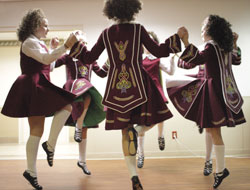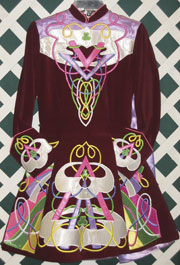It’s likely that when you hear the phrase Irish dancing, you immediately picture a line of dancers holding hands and stepping in unison to Celtic melodies and drum beats. The style is certainly unique and filled with tradition. The Flynn School of Irish Dance in West Peoria teaches students the steps which make up these heart-pounding shows.
Proud of their Irish heritage, Peggy Flynn Dwyer’s parents passed their pride on to their daughter, who grew up listening to Irish folk music. At age 15, she began dancing under the instruction of Tricia Dahlquist, founder of the Claddagh School of Irish Dance. “She was a great inspiration and mentor,” Flynn said, “under whom I taught for a couple of years before moving to Chicago.”
After returning to the Peoria area in 1996, Flynn was approached by friends about teaching Irish dancing to their children. She contacted the Peoria Park District’s Franciscan Recreation Center and inquired about renting the gym for her lessons. “When the facility manager discovered my plans were to teach Irish dancing, she asked if I would consider starting an Irish dancing program for the park district.” Flynn said she was very interested, and went on to teach her first class of five students in April of 1997. The costumes worn by the Peoria Park District Irish Dancers consisted of mere polo shirts and shorts—a far cry from the ornate dresses worn today by Flynn’s students. It was a great start, however!
By the following summer, Flynn’s classes had grown considerably. After receiving a mother’s request, she decided to add a new location in Bloomington as well. The woman wanted her children to study with Flynn so much that she offered to find a location for the lessons if Flynn would agree to make the trip to Bloomington each week. She agreed, changing the name of her school to the Flynn School of Irish Dance, and taught classes at the McLean County Dance Studio from 1998 to 2001.
As her classes kept growing, Flynn added a third location and contacted Mary Price Boday, who founded the Central Illinois Dance Studio. Flynn began teaching classes there in September of 1999, and by the summer of 2001, she had transferred all of her classes to this location. In June of 2002, she moved the Flynn School of Irish Dance to its current location on North Sterling Avenue in West Peoria. When teaching classes in three locations, Flynn had about 125 students. Since her move to the West Peoria location, she has had “a steady stream of about 80 students.”
 The Flynn School of Irish Dance teaches both male and female students, ages three through adult. Pre-Irish dance lessons for ages three through six provide “a fun introduction to Irish music and movement,” Flynn explained. Some of the benefits of this type of dance include: developing coordination, balance, strength and poise; enhancing memory skills; taking pride in accomplishing goals; and building confidence and self-esteem.
The Flynn School of Irish Dance teaches both male and female students, ages three through adult. Pre-Irish dance lessons for ages three through six provide “a fun introduction to Irish music and movement,” Flynn explained. Some of the benefits of this type of dance include: developing coordination, balance, strength and poise; enhancing memory skills; taking pride in accomplishing goals; and building confidence and self-esteem.
“Dancers all start with the traditional Irish jig. After they’ve mastered the six steps of the jig, they move up to Level One. From there, all of the classes are taught specific dances, and the students must test on them before moving on to the next level.” Dancers in levels one and higher have the opportunity to join the dance team—Flynn’s Irish Dancers—which performs several times throughout the year.
Performances of Flynn’s Irish Dancers “combine traditional Irish step dance with contemporary music and original choreography,” running between 30 and 45 minutes long. The team rehearses anywhere from twice a month to every week, depending on the time of year. As it gets closer to St. Patrick’s Day and Erin Feis, Flynn said, rehearsals pick up.
Shows are tailored to each specific venue and audience. “We can perform just about anywhere there’s a flat surface,” Flynn said. “One of the dancers’ favorites is on top of the dugouts at O’Brien Field for the Peoria Chiefs. We also perform at the St. Patrick’s Society and the Friends of Clonmel functions, Kelleher’s Irish Pub, Paddy O’Flaherty’s Irish Pub, festivals, schools, libraries, retirement homes, private parties and wedding receptions.”
Irish dancers wear special costumes when performing. For girls, they consist of curly hair—usually wigs, a dress with a cape and poodle socks. “Each school has its own color scheme and Celtic designs on the dresses,” Flynn said. “Our designs are patterned after the designs on my solo costume. Since most girls don’t have naturally curly hair, we wear hairpieces or sleep in sponge rollers or soft spikes.”
 The Flynn School of Irish Dance has three different costumes for girls. Levels one through three wear a burgundy jumper and cape with a white blouse and lace headband. Levels four and up wear a fully-embroidered burgundy dress with a cape and an embroidered crown. Adults wear a black embroidered dress and cape. “Years ago, boys used to wear kilts and jackets. Now most boys wear long pants and dress shirts with ties.”
The Flynn School of Irish Dance has three different costumes for girls. Levels one through three wear a burgundy jumper and cape with a white blouse and lace headband. Levels four and up wear a fully-embroidered burgundy dress with a cape and an embroidered crown. Adults wear a black embroidered dress and cape. “Years ago, boys used to wear kilts and jackets. Now most boys wear long pants and dress shirts with ties.”
The shoes of Irish dancers are probably the most important parts of their costumes. Depending on the type of dance, dancers wear either soft shoes called gillies or heavy shoes with fiberglass tips and hollow heels. It’s the hollow heels which “make a wooden sound when tapped,” Flynn explained. Gillies are similar to ballet shoes, but lace up the front and tie around the ankles or arch of the foot.
Flynn thoroughly enjoys teaching Irish dance to all ages and getting to know the families with whom she works. “It’s so rewarding to teach a dancer week after week and watch her face light up with excitement when she finally gets that step she’s been working on so diligently! I’ve not only watched them grow in Irish dancing, but I’ve watched them make their first communions, start driving, graduate from high school…They are ‘my kids,’ and I’m proud of every one of them.” Flynn said she loves it when parents tell her that their children dance all the time. One mother said, “Her feet don’t stop. In the grocery store, down the hall, in the kitchen, everywhere!” Flynn said, “That’s when I know I’ve done my job; I’ve passed my passion on to someone else.” a&s


